Case Study: Decision-Making in Investment at AJ plc Company
VerifiedAdded on 2023/06/17
|8
|1448
|244
Essay
AI Summary
This essay provides a comprehensive analysis of business decision-making using the case study of AJ plc, a chocolate manufacturing company. The strategic managers are considering investing in either vegan chocolates or vegan spread production. The essay employs tools such as payback period an...
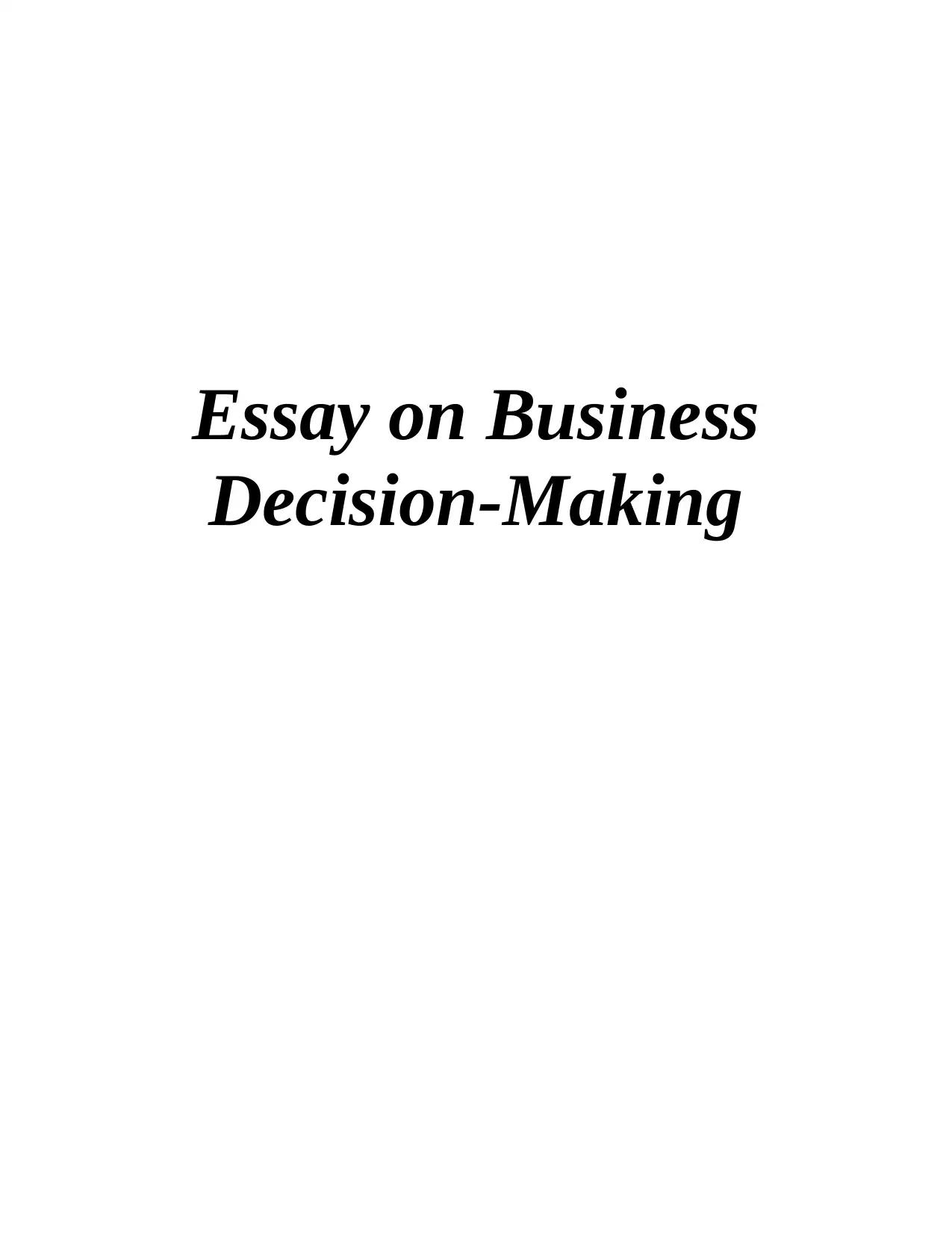
Essay on Business
Decision-Making
Decision-Making
Paraphrase This Document
Need a fresh take? Get an instant paraphrase of this document with our AI Paraphraser

Table of Contents
INTRODUCTION ..........................................................................................................................3
TASK ..............................................................................................................................................3
CONCLUSION ...............................................................................................................................6
REFERENCES................................................................................................................................7
INTRODUCTION ..........................................................................................................................3
TASK ..............................................................................................................................................3
CONCLUSION ...............................................................................................................................6
REFERENCES................................................................................................................................7
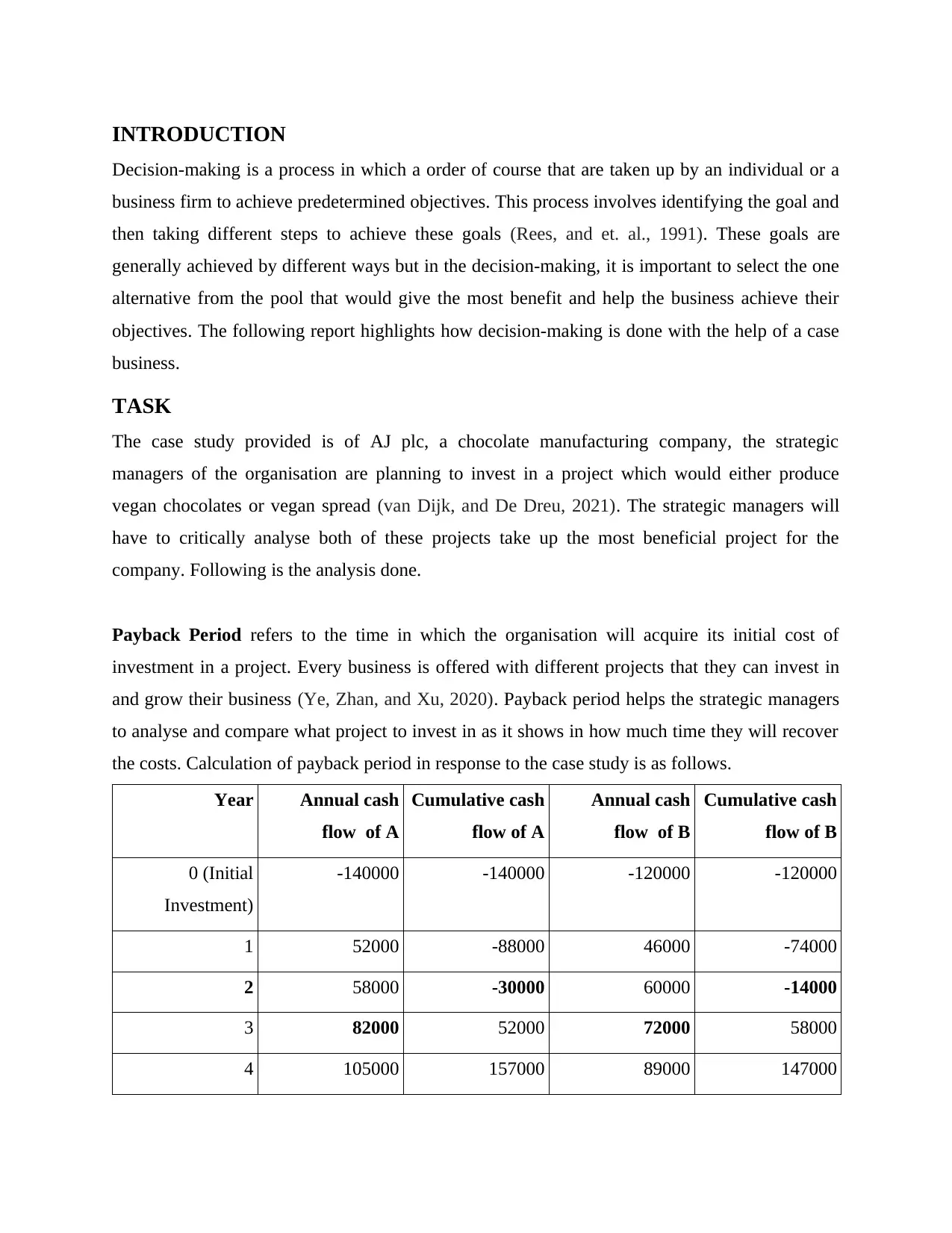
INTRODUCTION
Decision-making is a process in which a order of course that are taken up by an individual or a
business firm to achieve predetermined objectives. This process involves identifying the goal and
then taking different steps to achieve these goals (Rees, and et. al., 1991). These goals are
generally achieved by different ways but in the decision-making, it is important to select the one
alternative from the pool that would give the most benefit and help the business achieve their
objectives. The following report highlights how decision-making is done with the help of a case
business.
TASK
The case study provided is of AJ plc, a chocolate manufacturing company, the strategic
managers of the organisation are planning to invest in a project which would either produce
vegan chocolates or vegan spread (van Dijk, and De Dreu, 2021). The strategic managers will
have to critically analyse both of these projects take up the most beneficial project for the
company. Following is the analysis done.
Payback Period refers to the time in which the organisation will acquire its initial cost of
investment in a project. Every business is offered with different projects that they can invest in
and grow their business (Ye, Zhan, and Xu, 2020). Payback period helps the strategic managers
to analyse and compare what project to invest in as it shows in how much time they will recover
the costs. Calculation of payback period in response to the case study is as follows.
Year Annual cash
flow of A
Cumulative cash
flow of A
Annual cash
flow of B
Cumulative cash
flow of B
0 (Initial
Investment)
-140000 -140000 -120000 -120000
1 52000 -88000 46000 -74000
2 58000 -30000 60000 -14000
3 82000 52000 72000 58000
4 105000 157000 89000 147000
Decision-making is a process in which a order of course that are taken up by an individual or a
business firm to achieve predetermined objectives. This process involves identifying the goal and
then taking different steps to achieve these goals (Rees, and et. al., 1991). These goals are
generally achieved by different ways but in the decision-making, it is important to select the one
alternative from the pool that would give the most benefit and help the business achieve their
objectives. The following report highlights how decision-making is done with the help of a case
business.
TASK
The case study provided is of AJ plc, a chocolate manufacturing company, the strategic
managers of the organisation are planning to invest in a project which would either produce
vegan chocolates or vegan spread (van Dijk, and De Dreu, 2021). The strategic managers will
have to critically analyse both of these projects take up the most beneficial project for the
company. Following is the analysis done.
Payback Period refers to the time in which the organisation will acquire its initial cost of
investment in a project. Every business is offered with different projects that they can invest in
and grow their business (Ye, Zhan, and Xu, 2020). Payback period helps the strategic managers
to analyse and compare what project to invest in as it shows in how much time they will recover
the costs. Calculation of payback period in response to the case study is as follows.
Year Annual cash
flow of A
Cumulative cash
flow of A
Annual cash
flow of B
Cumulative cash
flow of B
0 (Initial
Investment)
-140000 -140000 -120000 -120000
1 52000 -88000 46000 -74000
2 58000 -30000 60000 -14000
3 82000 52000 72000 58000
4 105000 157000 89000 147000
⊘ This is a preview!⊘
Do you want full access?
Subscribe today to unlock all pages.

Trusted by 1+ million students worldwide
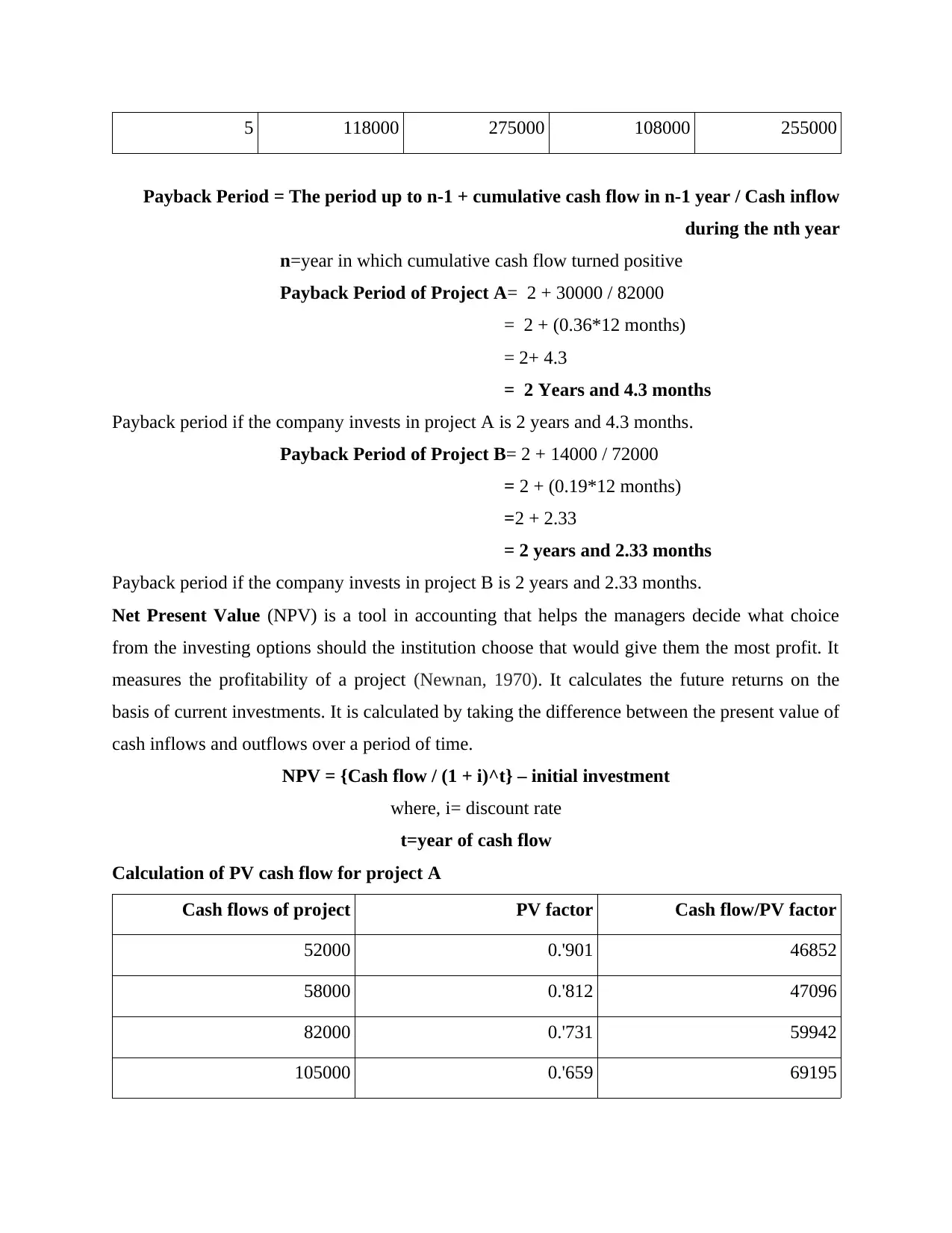
5 118000 275000 108000 255000
Payback Period = The period up to n-1 + cumulative cash flow in n-1 year / Cash inflow
during the nth year
n=year in which cumulative cash flow turned positive
Payback Period of Project A= 2 + 30000 / 82000
= 2 + (0.36*12 months)
= 2+ 4.3
= 2 Years and 4.3 months
Payback period if the company invests in project A is 2 years and 4.3 months.
Payback Period of Project B= 2 + 14000 / 72000
= 2 + (0.19*12 months)
=2 + 2.33
= 2 years and 2.33 months
Payback period if the company invests in project B is 2 years and 2.33 months.
Net Present Value (NPV) is a tool in accounting that helps the managers decide what choice
from the investing options should the institution choose that would give them the most profit. It
measures the profitability of a project (Newnan, 1970). It calculates the future returns on the
basis of current investments. It is calculated by taking the difference between the present value of
cash inflows and outflows over a period of time.
NPV = {Cash flow / (1 + i)^t} – initial investment
where, i= discount rate
t=year of cash flow
Calculation of PV cash flow for project A
Cash flows of project PV factor Cash flow/PV factor
52000 0.'901 46852
58000 0.'812 47096
82000 0.'731 59942
105000 0.'659 69195
Payback Period = The period up to n-1 + cumulative cash flow in n-1 year / Cash inflow
during the nth year
n=year in which cumulative cash flow turned positive
Payback Period of Project A= 2 + 30000 / 82000
= 2 + (0.36*12 months)
= 2+ 4.3
= 2 Years and 4.3 months
Payback period if the company invests in project A is 2 years and 4.3 months.
Payback Period of Project B= 2 + 14000 / 72000
= 2 + (0.19*12 months)
=2 + 2.33
= 2 years and 2.33 months
Payback period if the company invests in project B is 2 years and 2.33 months.
Net Present Value (NPV) is a tool in accounting that helps the managers decide what choice
from the investing options should the institution choose that would give them the most profit. It
measures the profitability of a project (Newnan, 1970). It calculates the future returns on the
basis of current investments. It is calculated by taking the difference between the present value of
cash inflows and outflows over a period of time.
NPV = {Cash flow / (1 + i)^t} – initial investment
where, i= discount rate
t=year of cash flow
Calculation of PV cash flow for project A
Cash flows of project PV factor Cash flow/PV factor
52000 0.'901 46852
58000 0.'812 47096
82000 0.'731 59942
105000 0.'659 69195
Paraphrase This Document
Need a fresh take? Get an instant paraphrase of this document with our AI Paraphraser
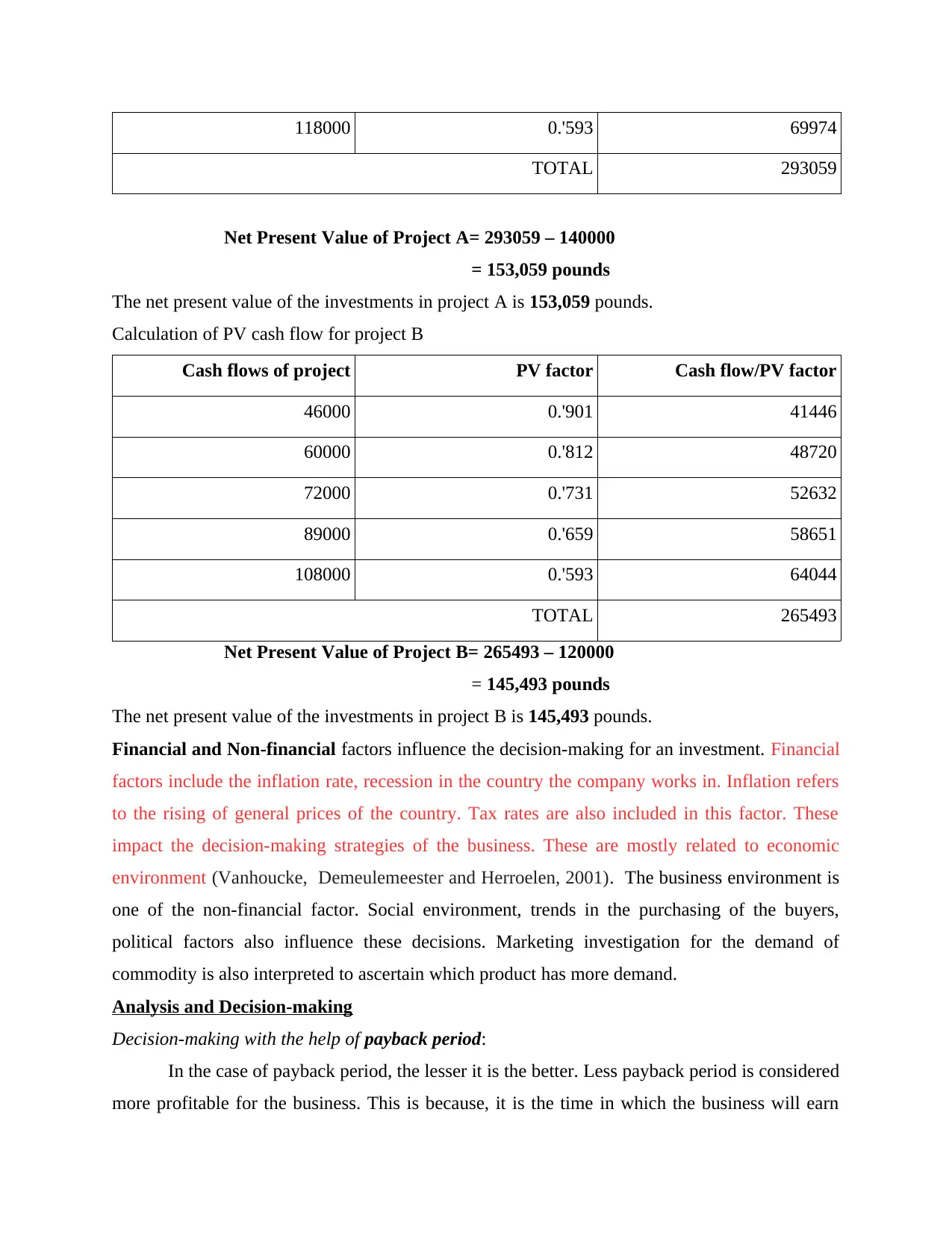
118000 0.'593 69974
TOTAL 293059
Net Present Value of Project A= 293059 – 140000
= 153,059 pounds
The net present value of the investments in project A is 153,059 pounds.
Calculation of PV cash flow for project B
Cash flows of project PV factor Cash flow/PV factor
46000 0.'901 41446
60000 0.'812 48720
72000 0.'731 52632
89000 0.'659 58651
108000 0.'593 64044
TOTAL 265493
Net Present Value of Project B= 265493 – 120000
= 145,493 pounds
The net present value of the investments in project B is 145,493 pounds.
Financial and Non-financial factors influence the decision-making for an investment. Financial
factors include the inflation rate, recession in the country the company works in. Inflation refers
to the rising of general prices of the country. Tax rates are also included in this factor. These
impact the decision-making strategies of the business. These are mostly related to economic
environment (Vanhoucke, Demeulemeester and Herroelen, 2001). The business environment is
one of the non-financial factor. Social environment, trends in the purchasing of the buyers,
political factors also influence these decisions. Marketing investigation for the demand of
commodity is also interpreted to ascertain which product has more demand.
Analysis and Decision-making
Decision-making with the help of payback period:
In the case of payback period, the lesser it is the better. Less payback period is considered
more profitable for the business. This is because, it is the time in which the business will earn
TOTAL 293059
Net Present Value of Project A= 293059 – 140000
= 153,059 pounds
The net present value of the investments in project A is 153,059 pounds.
Calculation of PV cash flow for project B
Cash flows of project PV factor Cash flow/PV factor
46000 0.'901 41446
60000 0.'812 48720
72000 0.'731 52632
89000 0.'659 58651
108000 0.'593 64044
TOTAL 265493
Net Present Value of Project B= 265493 – 120000
= 145,493 pounds
The net present value of the investments in project B is 145,493 pounds.
Financial and Non-financial factors influence the decision-making for an investment. Financial
factors include the inflation rate, recession in the country the company works in. Inflation refers
to the rising of general prices of the country. Tax rates are also included in this factor. These
impact the decision-making strategies of the business. These are mostly related to economic
environment (Vanhoucke, Demeulemeester and Herroelen, 2001). The business environment is
one of the non-financial factor. Social environment, trends in the purchasing of the buyers,
political factors also influence these decisions. Marketing investigation for the demand of
commodity is also interpreted to ascertain which product has more demand.
Analysis and Decision-making
Decision-making with the help of payback period:
In the case of payback period, the lesser it is the better. Less payback period is considered
more profitable for the business. This is because, it is the time in which the business will earn
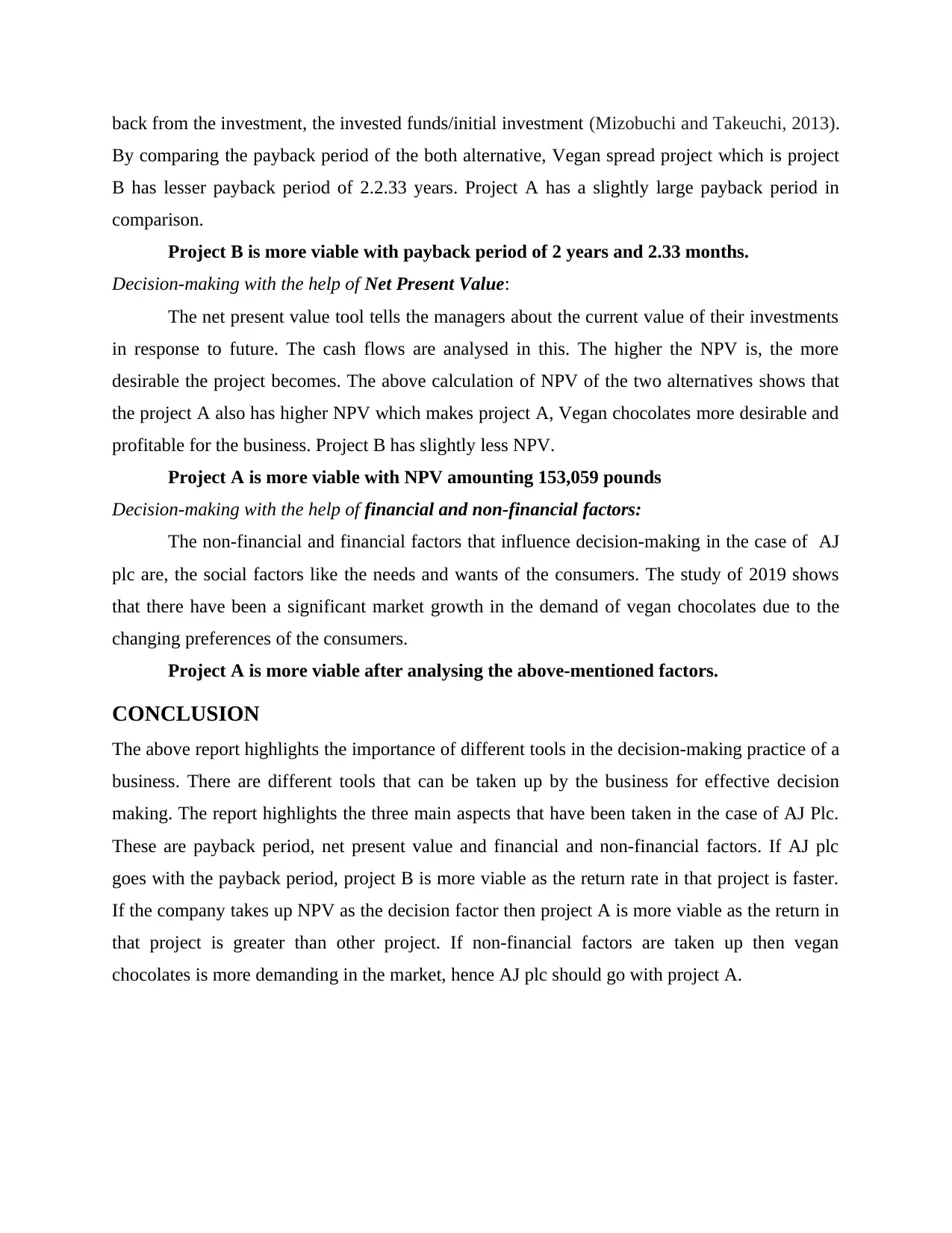
back from the investment, the invested funds/initial investment (Mizobuchi and Takeuchi, 2013).
By comparing the payback period of the both alternative, Vegan spread project which is project
B has lesser payback period of 2.2.33 years. Project A has a slightly large payback period in
comparison.
Project B is more viable with payback period of 2 years and 2.33 months.
Decision-making with the help of Net Present Value:
The net present value tool tells the managers about the current value of their investments
in response to future. The cash flows are analysed in this. The higher the NPV is, the more
desirable the project becomes. The above calculation of NPV of the two alternatives shows that
the project A also has higher NPV which makes project A, Vegan chocolates more desirable and
profitable for the business. Project B has slightly less NPV.
Project A is more viable with NPV amounting 153,059 pounds
Decision-making with the help of financial and non-financial factors:
The non-financial and financial factors that influence decision-making in the case of AJ
plc are, the social factors like the needs and wants of the consumers. The study of 2019 shows
that there have been a significant market growth in the demand of vegan chocolates due to the
changing preferences of the consumers.
Project A is more viable after analysing the above-mentioned factors.
CONCLUSION
The above report highlights the importance of different tools in the decision-making practice of a
business. There are different tools that can be taken up by the business for effective decision
making. The report highlights the three main aspects that have been taken in the case of AJ Plc.
These are payback period, net present value and financial and non-financial factors. If AJ plc
goes with the payback period, project B is more viable as the return rate in that project is faster.
If the company takes up NPV as the decision factor then project A is more viable as the return in
that project is greater than other project. If non-financial factors are taken up then vegan
chocolates is more demanding in the market, hence AJ plc should go with project A.
By comparing the payback period of the both alternative, Vegan spread project which is project
B has lesser payback period of 2.2.33 years. Project A has a slightly large payback period in
comparison.
Project B is more viable with payback period of 2 years and 2.33 months.
Decision-making with the help of Net Present Value:
The net present value tool tells the managers about the current value of their investments
in response to future. The cash flows are analysed in this. The higher the NPV is, the more
desirable the project becomes. The above calculation of NPV of the two alternatives shows that
the project A also has higher NPV which makes project A, Vegan chocolates more desirable and
profitable for the business. Project B has slightly less NPV.
Project A is more viable with NPV amounting 153,059 pounds
Decision-making with the help of financial and non-financial factors:
The non-financial and financial factors that influence decision-making in the case of AJ
plc are, the social factors like the needs and wants of the consumers. The study of 2019 shows
that there have been a significant market growth in the demand of vegan chocolates due to the
changing preferences of the consumers.
Project A is more viable after analysing the above-mentioned factors.
CONCLUSION
The above report highlights the importance of different tools in the decision-making practice of a
business. There are different tools that can be taken up by the business for effective decision
making. The report highlights the three main aspects that have been taken in the case of AJ Plc.
These are payback period, net present value and financial and non-financial factors. If AJ plc
goes with the payback period, project B is more viable as the return rate in that project is faster.
If the company takes up NPV as the decision factor then project A is more viable as the return in
that project is greater than other project. If non-financial factors are taken up then vegan
chocolates is more demanding in the market, hence AJ plc should go with project A.
⊘ This is a preview!⊘
Do you want full access?
Subscribe today to unlock all pages.

Trusted by 1+ million students worldwide

Paraphrase This Document
Need a fresh take? Get an instant paraphrase of this document with our AI Paraphraser
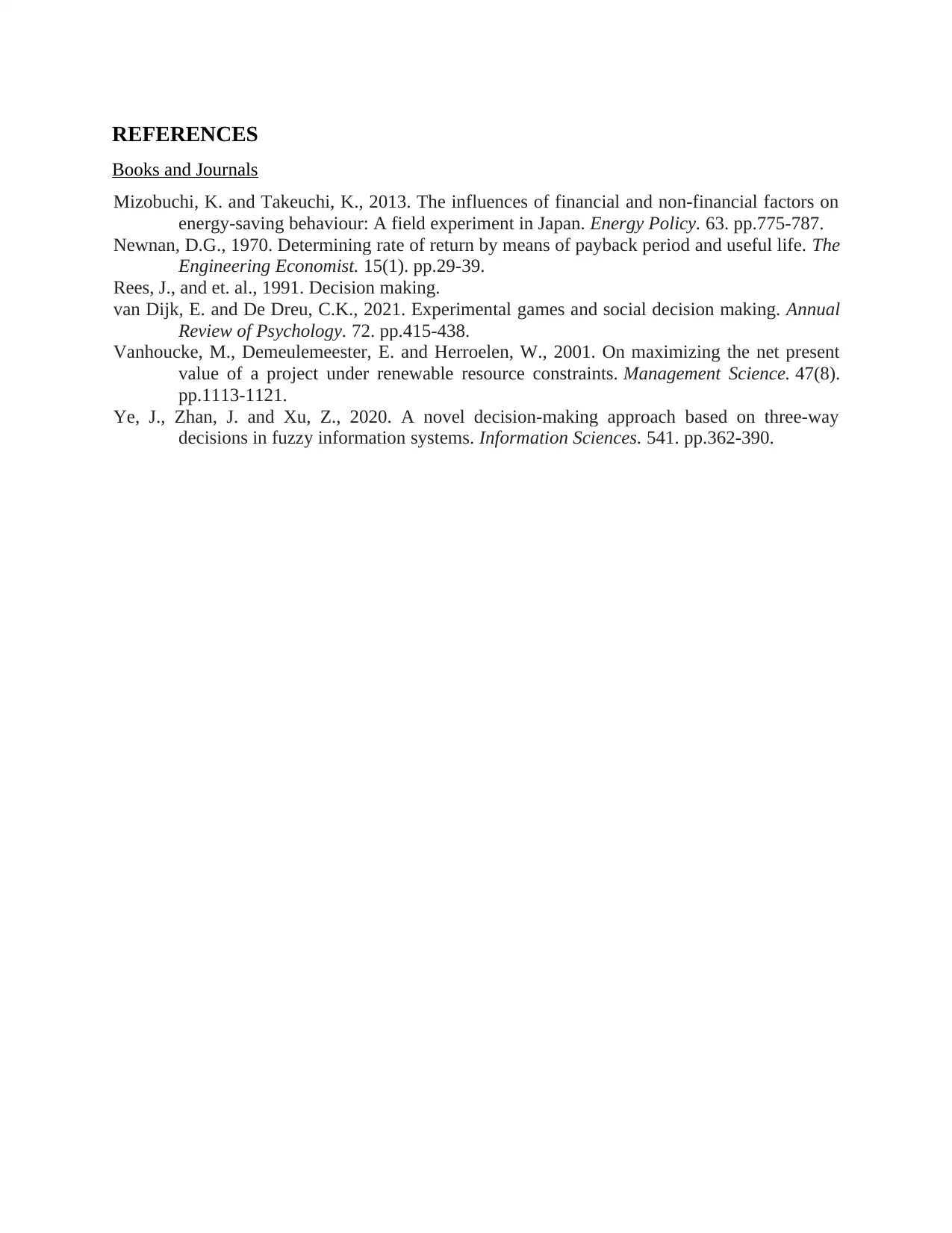
REFERENCES
Books and Journals
Mizobuchi, K. and Takeuchi, K., 2013. The influences of financial and non-financial factors on
energy-saving behaviour: A field experiment in Japan. Energy Policy. 63. pp.775-787.
Newnan, D.G., 1970. Determining rate of return by means of payback period and useful life. The
Engineering Economist. 15(1). pp.29-39.
Rees, J., and et. al., 1991. Decision making.
van Dijk, E. and De Dreu, C.K., 2021. Experimental games and social decision making. Annual
Review of Psychology. 72. pp.415-438.
Vanhoucke, M., Demeulemeester, E. and Herroelen, W., 2001. On maximizing the net present
value of a project under renewable resource constraints. Management Science. 47(8).
pp.1113-1121.
Ye, J., Zhan, J. and Xu, Z., 2020. A novel decision-making approach based on three-way
decisions in fuzzy information systems. Information Sciences. 541. pp.362-390.
Books and Journals
Mizobuchi, K. and Takeuchi, K., 2013. The influences of financial and non-financial factors on
energy-saving behaviour: A field experiment in Japan. Energy Policy. 63. pp.775-787.
Newnan, D.G., 1970. Determining rate of return by means of payback period and useful life. The
Engineering Economist. 15(1). pp.29-39.
Rees, J., and et. al., 1991. Decision making.
van Dijk, E. and De Dreu, C.K., 2021. Experimental games and social decision making. Annual
Review of Psychology. 72. pp.415-438.
Vanhoucke, M., Demeulemeester, E. and Herroelen, W., 2001. On maximizing the net present
value of a project under renewable resource constraints. Management Science. 47(8).
pp.1113-1121.
Ye, J., Zhan, J. and Xu, Z., 2020. A novel decision-making approach based on three-way
decisions in fuzzy information systems. Information Sciences. 541. pp.362-390.
1 out of 8
Related Documents
Your All-in-One AI-Powered Toolkit for Academic Success.
+13062052269
info@desklib.com
Available 24*7 on WhatsApp / Email
![[object Object]](/_next/static/media/star-bottom.7253800d.svg)
Unlock your academic potential
© 2024 | Zucol Services PVT LTD | All rights reserved.


